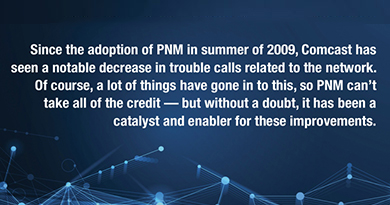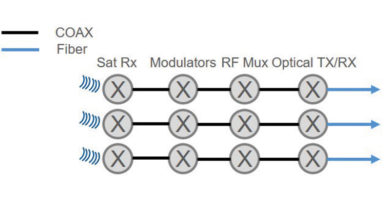Demystifying the Remote Optical Line Terminal
By Steve Harris and Adam Soccorsy
Most broadband operators widely adopt fiber-to-the-home (FTTH) passive optical networks (PONs) by employing a centralized optical line terminal (OLT) situated in a facility referred to as a headend, central office (CO), or data center. The OLT plays a pivotal role in efficiently managing the bi-directional traffic distribution between the broadband operator’s network and the customer premises equipment (CPE). This seamless coordination ensures smooth and reliable communication services for subscribers.
As technology and network demands progress, broadband operators are constantly refining their FTTH networks, leading to the integration of a crucial component known as the remote OLT (rOLT). This innovation complements the traditional OLT by extending its functionalities to remote locations, bringing greater flexibility and scalability to a broadband operator’s network. The rOLT serves as the intelligent access point in the PON architecture, facilitating seamless connectivity for CPE, optical network units (ONUs), or optical network terminals (ONTs) situated farther from the central facility, and linking back to an aggregation or Layer 3 (L3) IP network. This extension of the OLT’s capabilities allows broadband operators to efficiently serve a broader geographical area and cater to the growing demand for high-speed Internet (HSI) and reliable fiber optic services; it also allows for several other niche applications such as multiple dwelling units (MDUs), business-to-business (B2B), and suburban infill.
In order to enhance the customer quality of experience (QoE) and optimize the FTTH network key performance indicators (KPIs), broadband operators strategically deploy rOLTs in closer proximity to the customer’s premises, often within the local neighborhood or at distribution points in the access network. The concept of rOLTs aligns with fiber-to-the-curb (FTTC) or fiber-to-the-distribution point (FTTdp) architectures, where the focus is on minimizing the distance between the customer and the network access point (NAP).
Remote PHY (R-PHY) / remote MACPHY (R-MACPHY) are other versions of “remote” architectures similar to rOLTs, where the media access control (MAC) processing is compressed and executed locally in addition to other layer functions processing. By situating the rOLT closer to the customer in the access network, this deployment offers several advantages for a broadband operator. In modern digital FTTH networks, the transmission distance is typically limited to around 20 kilometers (km). By incorporating rOLTs, broadband operators may significantly reduce the amount of expensive fiber and construction time required to connect subscribers. This reduction in fiber length and construction needs translates to cost savings and quicker broadband deployment times.
Moreover, rOLTs enable the provisioning of higher bandwidth to subscribers, often exceeding 10 Gbps (e.g., XGS-PON), leading to improved KPIs, improved QoE, and faster upstream/downstream data rates. Additionally, the reduced distance between the OLT and the CPE results in lower latency, enhancing the performance of real-time applications for subscribers.

Figure 1. SCTE approach for rOLT
Another crucial benefit of rOLTs is their contribution to a more agile, flexible, and scalable FTTH network design for broadband operators. This enhanced flexibility facilitates easier expansion of fiber-based services to a larger customer base without requiring major infrastructure overhauls.
Improved customer QoE, efficient network operations, and future-proof scalability are some of the advantages of planning with rOLTs. Some network planning models show smaller upfront investments are required to begin constructing a rural network with rOLTs, which lowers the barriers to start many projects.
There are several architectures that support rOLT. For operators that have deployed distributed access architectures (DAAs) or distributed converged cable access platform (CCAP) architectures (DCA), they have the ability to add a rOLT component to a remote PHY device (RPD). This addition to the RPD allows broadband operators to deploy FTTH networks where a traditional DOCSIS® footprints exist. A broadband operator may offer FTTH to up to 512 subscribers with such a solution. Furthermore, equipment vendors have been able to enable DOCSIS Provisioning of EPON (DPoE) which allows for an ONU to appear on the CCAP network management system (NMS). SCTE® has standardized the RPD housing enclosure under ANSI/SCTE 273-1 2021 called generic access platform (GAP) enclosure specification. The housing components are standardized under ANSI/SCTE 273-2 2021 GAP modules specification.
By adhering to these standardized specifications, broadband operators can achieve greater interoperability and efficiency in their FTTH network expansions, making it easier to integrate rOLT seamlessly into their existing infrastructure. This approach empowers broadband operators to provide HSI fiber-based services in areas where traditional cable technologies were previously dominant, fostering the development of robust and future-proofed broadband networks.
In addition to integrating rOLTs into DAA and DCA, operators also have the option to deploy rOLTs in other network configurations. This may be achieved by leveraging high-speed network-to-network interface (NNI) digital fiber links, capable of handling 10 Gbps or more, to connect the rOLTs with a cross connect (cX) deep within the access network. In this deployment scenario, the 10 Gbps+ NNI digital fiber links serve as the backbone of the network, facilitating efficient and high-capacity data transmission between the R-OLTs and the cX point. The rOLTs are strategically positioned at remote locations closer to the end-users’ premises, while the cX acts as a central aggregation point for the network traffic. The 10 Gbps+ capability of the NNI links allows for ample room for network growth and scalability to accommodate future bandwidth requirements.
The integration of rOLTs in the construction of fiber networks is a watershed moment in the evolution of OLTs in the access network of broadband operators, whether deployed in conjunction with DAA/DCA or through digital fiber links. rOLTs will contribute to a more cost-effective and agile infrastructure type that allows operators to expand fiber coverage in diverse geographies and using more of them will help to close the digital divide.

Figure 2. Technetix approach for rOLT

Steven Harris
VP Global Market Development,
SCTE® a subsidiary of CableLabs®

Adam Soccorsy,
Converged Network Specialist,
Technetix
Adam Soccorsy was appointed Director of Sales FTTx Systems in 2023 driving new business in fiber system technologies globally. He is an experienced executive having worked in broadband his entire career. Adam was previously a shareholder of a successful UK cable vendor which was later acquired. Prior to Technetix, Adam was senior procurement specialist at Liberty Global for XGS-PON, DAA, etc.
Figures provide by authors.



